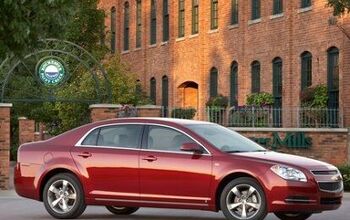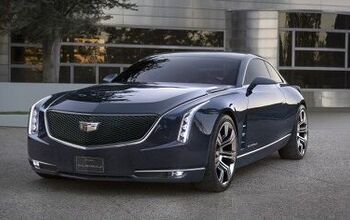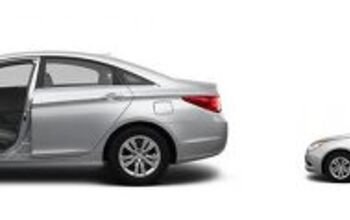GM Will Build Less To Make More

“In attempts to boost profitability, GM wants to cut the number of vehicle platforms by half over the next decade and consolidate the number of engines,” reports the DetN. That’s the good news. The bad news is that “GM’s executives admit the automaker continues to have an inefficient manufacturing network, weak supplier relations and too many variations in the types of engines and vehicle underpinnings it uses to build cars and trucks globally.” If the DetN says it, then it must be true. Putting platforms and engines on a diet is seen as the cure.
Mary Barra, GM’s product chief, told the DetN and an assemblage of Wall Street analysts that by 2018, “GM hopes to build 90 percent of its vehicles on 14 platforms — half the number now — and boost manufacturing efficiency by 40 percent.” Not to nitpick, but if you build 90 percent of your vehicles on 14 platforms, then you can’t build the remaining 10 percent on thin air and you will need more platforms for low volume cars. So we talked a bit to GM to find out more about how they will go from zaftig to svelte.
The basic story is that GM is trying to streamline its “too many variations in the types of engines and vehicle underpinnings,” and this is a good thing.
Currently, only a third of GM’s volume comes from cars that share what GM calls “core architectures.” The rest sits on a hodgepodge of what GM charitably calls “regional architectures.” Currently, there are 30 “Core Architectures” and an untold number of regional dishes.
In the future, GM’s local chefs will have to use a common cookbook. By 2014, in the world of cars that is tomorrow, the number of “Core Architectures” will shrink to 24, but the global volume that uses these core architectures will grow to 62 percent. Four years later, by 2018, all regional architectures will have vanished. The number of global architectures will have shrunk to 14. Those 14 global architectures will serve 90 percent of the volume.
But again, what about the remaining 10 percent? “There are a few cars that have a unique architecture, which they share with nobody,” explains Klaus-Peter Martin, GM spokesman in Detroit. As examples, he names the Chevrolet Corvette and some vehicles produced with GM’s JV partners in China.
Likewise, the number of engine platforms will shrink from currently around 20 to less than 10 in 2018. Keep in mind theses are engine platforms, which allow a multitude of engines.
GM expects global efficiency gains between 35 and 40 percent from this, which is a tall order. But if you look at how little global commonality there is currently in the world of GM, those numbers should be doable. With a lot of screaming from the natives.
Michelle Krebs of Edmunds says “it’s the course a lot of manufacturers are taking. Everyone is trying to get to greater economies of scale.”
Volkswagen for instance is moving away from platform-think and goes to its new kit architecture. This allows a much higher number of different cars with different character, built from modules. Object-oriented car design, if you will. On a smaller scale, BMW creates a number of engines, gasoline and diesel, from one building block, a single, standardized cylinder.
This industry takes huge investments, and spreading them across as many units as possible is the name of the game. If you make the most from the least, you win. Don’t think “badge engineering” when you hear this. If done right, the slimdown can make the offerings more attractive, and can help the brand(s) gain sex-appeal. That of course remains in the eye of the beholder. If you like the right lady, you’ll complain that the left one is the wrong one.

Bertel Schmitt comes back to journalism after taking a 35 year break in advertising and marketing. He ran and owned advertising agencies in Duesseldorf, Germany, and New York City. Volkswagen A.G. was Bertel's most important corporate account. Schmitt's advertising and marketing career touched many corners of the industry with a special focus on automotive products and services. Since 2004, he lives in Japan and China with his wife <a href="http://www.tomokoandbertel.com"> Tomoko </a>. Bertel Schmitt is a founding board member of the <a href="http://www.offshoresuperseries.com"> Offshore Super Series </a>, an American offshore powerboat racing organization. He is co-owner of the racing team Typhoon.
More by Bertel Schmitt
Latest Car Reviews
Read moreLatest Product Reviews
Read moreRecent Comments
- Redapple2 I think I ve been in 100 plants. ~ 20 in Mexico. ~10 Europe. Balance usa. About 1/2 nonunion. I supervised UAW skilled trades guys at GM Powertrain for 6 years. I know the answer.PS- you do know GM products - sales weighted - average about 40% USA-Canada Content.
- Jrhurren Unions and ownership need to work towards the common good together. Shawn Fain is a clown who would love to drive the companies out of business (or offshored) just to claim victory.
- Redapple2 Tadge will be replaced with a girl. Even thought -today- only 13% of engineer -newly granted BS are female. So, a Tadge level job takes ~~ 25 yrs of experience, I d look at % in 2000. I d bet it was lower. Not higher. 10%. (You cannot believe what % of top jobs at gm are women. @ 10%. Jeez.)
- Redapple2 .....styling has moved into [s]exotic car territory[/s] tortured over done origami land. There; I fixed it. C 7 is best looking.
- TheEndlessEnigma Of course they should unionize. US based automotive production component production and auto assembly plants with unionized memberships produce the highest quality products in the automotive sector. Just look at the high quality products produced by GM, Ford and Chrysler!


































Comments
Join the conversation
Those posters who have mentioned GM selling different cars on the same platform in different markets. If your Buick drives like an Opel, will you care as long as you've never driven an Opel? Holdens that become Chevrolets (I pray.)
What took you so long?